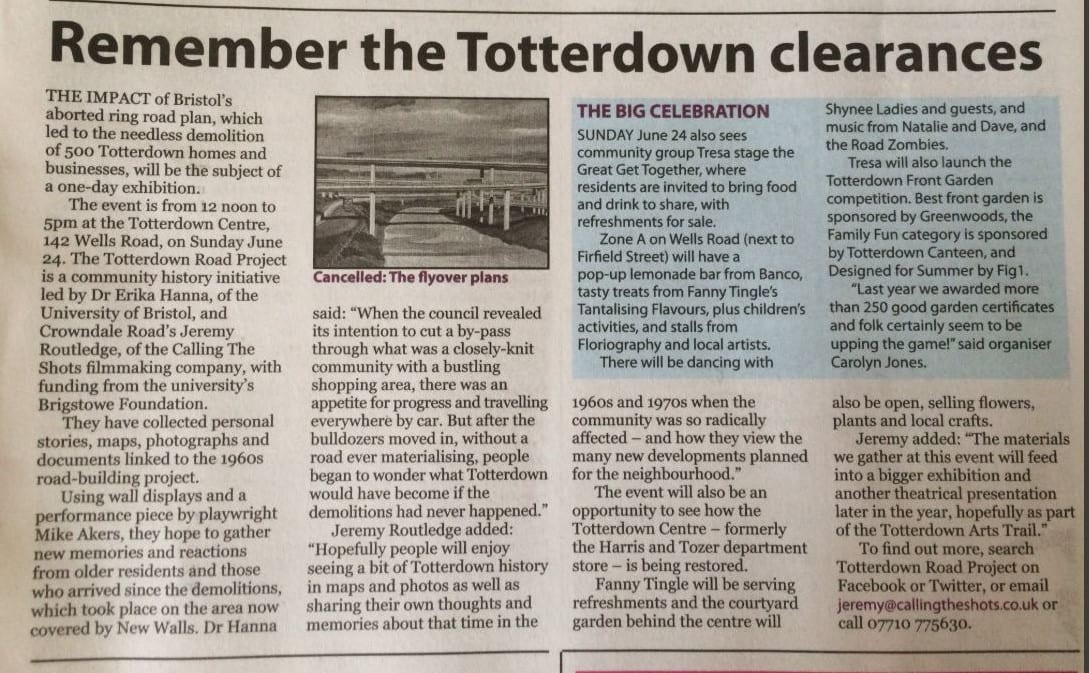The Road
How can an awareness of local history improve our understanding of our community?

In the 1960s, Totterdown, a Victorian suburb in Bristol’s south inner city, had been devastated by the demolition of 500 houses, and the relocation of 5,000 Bristolians, in order to make way for an ‘outer ring road’ and ‘transport interchange’ that were never built. The area bears the scars both physically, with the urban spoil between Temple Meads and Knowle, and emotionally, with a defensive and entrenched community wary of attempts at urban development. As Totterdown is once again undergoing urban change, living with uncertainty is something many of the area’s long-time residents know well.
The concept of a historic, unified community battling predatory property developers is familiar to many city-dwellers, particularly in Bristol.
What did the project involve?
This project involved a team of academic and non-academic researchers who sought to engage the local community in researching, devising, and making stories about their own neighbourhood – helping them to engage in broader debates about compromise and ideals in the modern metropolis.
The team comprised of Erika Hanna, a historian at the University of Bristol; representatives from the Totterdown Centre, a cultural hub; and the Wardrobe Theatre Ensemble. Together, they connected local people with their recent history and explored the contexts and issues that motivated planners then and now.
The team based its project at the new Totterdown Centre. They recruited 12 local volunteer researchers, all of whom focused on creating walking tours from encounters with archival materials. The archival work helped the team to curate, devise and recreate debates about the future of the area in the 1960s, culminating in a day of celebration at the Totterdown Centre. The volunteer researchers lead walks with locals, sharing all their local history knowledge with their neighbours. People were also able to participate in 1960s meeting reconstructions and in a debate about the Temple Quarter and Bath Road developments.
Who are the team and what do they bring?
- Erika Hanna, History (University of Bristol), has published extensively on the history of cities since 1945. She is on the editorial board of Urban History journal and is also a member of the steering committee of the Urban History Group.
- Jeremy Routledge (Calling the Shots) is a creative producer experienced in community engagement, delivering faciliatted strands for Arts Council England, European Social Fund, the BFI, Bristol City Council, DfE, Channel 4 and the BBC.
- Mike Akers and Jesse Jones, theatre makers (Wardrobe Ensemble) have previously explored the urban futurescapes of the 1960s, Brexit and austerity through theatre.
- Beks Herhat, , florist (Totterdown Centre) is a native Bristolian from St. George. Beks is a passionate member of the local community, spearheading the drive to renovate the almost derelict 1970s Totterdown Centre into a thriving local hub.
What were the results?
A video produced by the research team summarising the project and its outcomes can be viewed below:
The project culminated in a number of events to share their findings and present this local history to the public. One event was the LightBUGGY projects, headed by Andy McKeown which projected archival images of Totterdown onto current buildings in the area. Another event was The Missing Numbers which involved an exhibition, the local projection walks, and ‘Blue Plague’ trails.
The project caught the attention of the local community and the press with an article being published in Bristol Voice


